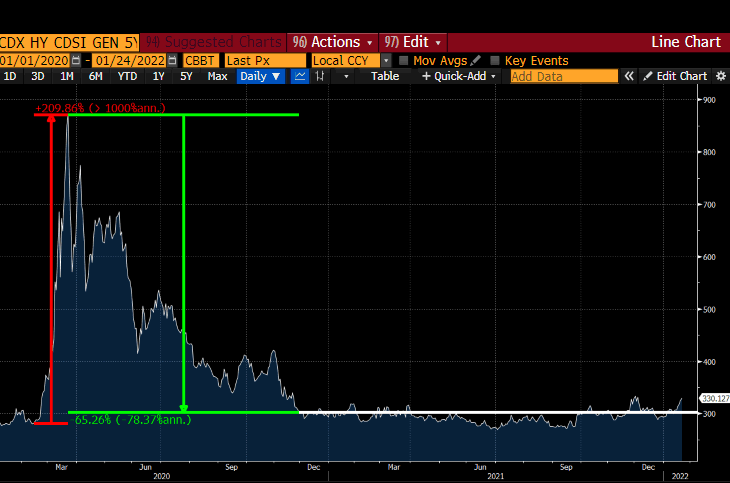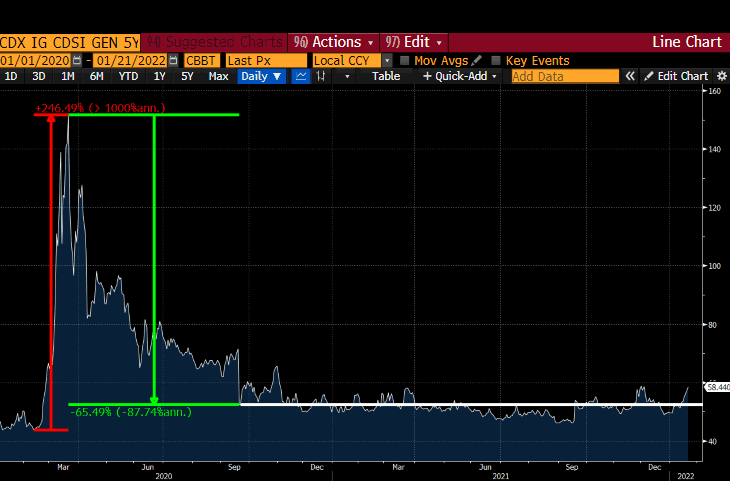
(Any views expressed in the below are the personal views of the author and should not form the basis for making investment decisions, nor be construed as a recommendation or advice to engage in investment transactions.)
Dump-eve
8:00 PM
Scanning the horizon, you giddily observe the accumulation of snowflakes. The forecast calls for DUMP. And you and the rest of the mountain town can barely contain your glee about the upcoming powder day.
You prepared accordingly:
- You tuned up your skis with temperature appropriate wax, and sharpened the edges. These planks of plastic, wood, and metal are going to fly.
- You made sure to stretch aggressively so that your legs are limber.
- And finally, you restrained yourself from getting blasted at the local tavern.
Dump-day
6:00 AM
Glorious snow glistens in the faint moonlight. It’s go time, but there are a few hours before the first lift opens. It’s time to prepare yourself for an epic day of shredding.
First you check your phone in order to ascertain the magnitude of the dump. Unfortunately you were a bit distracted because crypto prices also observed an overnight dump to the tune of 10% – 30%. Ouchie, but the markets are not important– it’s a fucking powder day!
The sweet smell of single origin Central American floral ground coffee beans fills the kitchen. You are stoked to try a new micro-lot of Panamanian Geisha beans. You brew a proper pour over filtered coffee, and sit down on your mat. First breath work, then a few light movements to limber up.
7:00 AM
Your crew is up and milling about the house. Everyone is preparing their breakfast and chatting about which runs the group will hit first. The order of operations is of utmost importance. It has been many moons since the last dump, and the ski town is restless. The group expects errbody to be searching for the same thing– untracked lines on steep faces. A plan is formed and everyone filters out to their rooms to get dressed.
8:30 AM
A decision is made; the group will work its way skier’s rightward across the mountain in order to maximise untouched pow pow. The group will avoid the obvious choice to ride the tram or gondola up for the first run. Not only do these lifts open 30 minutes after the first chair lifts, but by the time the group reaches the base of the mountain, there is already a line.
Small and tall conifers dot the landscape. Glades of tightly packed trees invite the intrepid skier. It is here the group begins the day’s powder journey, and it is here where nirvana is first achieved.
Your legs are ready for an incredible acceleration of exertion; there are no warm up runs on a powder day. You find your lines, and hit it.
Standing at the top of a steep section, you identify a small boulder with sufficient room to land a jump. You cannot know for sure the depth of the snow upon landing, but you go for it anyway. A few turns in, you check your speed before launching yourself off the natural feature. There is no turning back now.
In the air, you feel the rush of adrenaline and spot your landing. As you touch down, the fluffy champagne powder envelops you. Transformed into a snowy Jacques-Cousteau, you can barely see as you snorkel through the snow. The landing is filled to an unknown depth of powder– it is essentially bottomless. You yelp with powder screams of joy and shout to your compatriots, signifying your joy at the discovery of bottomless powder.
4:00 PM
A full, beautiful day’s worth of skiing is behind you. It’s time to recount your best turns and tricks with the group while imbibing pitchers of alcoholic libations.
Now that the skiing is done, you pull out your phone and take a look at the crypto markets. Bottomless can both describe your magical day of skiing, and the state of the markets as resistance level after resistance level was breached. You check the mainstream financial press, the authors seem to gloat on how the total crypto market cap has lost upwards of $1 trillion since it’s ATH. It’s as if the authors wagged their collective elitist fingers and whispered “told ya so”.
But enough with the doom and gloom– it’s time to go home and prepare for tomorrow. An epsom salt bath is in order to sooth your muscles. And then, it’s off to dinner and an early bedtime.
Post-Dump
9:00 AM
There was no new snow overnight. Sad face.
Now you must begin a scavenger hunt for overlooked soft snow. The way in which you blithely took turns close to trees, and jumped off boulders the day previous is not repeated. The ruts and grooves of thousands of turns across the mountain the day prior creates hard packed areas of snow. You must scout your landings and turns with more care.
But … but there are still pockets of heaven to be found on the mountain. It requires taking more aggressive lines, and eschewing laziness for a steadfast dedication to the hunt for powder.
4:00 PM
Another solid day of skiing complete. With a bit more effort, patches of untouched or soft snow were located and shredded.
Again it’s time to pull out your phone and observe the state of the markets. Are crypto valuations still bottomless, or have the ruts been filled with the blood and tears of those who closed their positions?
Are We Done Yet?
Three weeks ago I penned an essay called Maelstrom, and in it I described the thought process that led me to rationalise my crypto portfolio to holding only Bitcoin, Ether, and a handful of shitcoins I really believe in.
While many appreciated my candor and views, there were others who correctly pointed out my bearish essay was published weeks after Bitcoin and Ether had already slumped over 30% from their ATH. My essays are just that– essays. They are, I hope, cogent pieces of prose that advance a thesis supported by logic and evidence. I am not here to help you definitively time the market, but rather to challenge your point of view and hopefully help you grow as a trader / investor.
The crypto capital markets are the last free financial markets on earth. All other major asset classes and the intermediaries who help people trade these financial products have become political targets of governments and their central bankers.
“When a measure becomes a target, it ceases to be a good measure” – Goodhart’s law.
Equity, fixed income, and currency markets are infected with the largesse of central and “too big to fail” banks. That means that they can run infinite leverage on the backs of the taxpayer, with the consequence being inflation created by wanton money printing. These banks’ balance sheets are used to pin asset prices to politically expedient levels. This benefits the wealthy, as in every society, the distribution of financial asset ownership is highly concentrated in the top 10% or 1% of the citizenry.
Crypto is wholly outside the TradFi system, and thus finds a market clearing level well before stonks or bonds. Crypto is now a real asset class, traded by plebes like us, hedge fund masters of the universe, and a smattering of sell-side banks.
Crypto as the last functioning true free financial market will find a clearing price on the up and downside that reflects the current macro economic environment well before all other assets.
My belief in the above statement leads me to a bit of a conundrum.
In the first three weeks of the year, the crypto markets traded down sharply. The American equity markets– and by that, I only mean the index prices of the S&P 500 and Nasdaq 100– are slightly off their all time highs. Equity markets are certainly not in a true bear market yet. But the capital destruction visited upon crypto holders suggests that the future removal of USD liquidity by the Federal Reserve in their renewed fight against inflation will visit equity index holders in short order.
That is fine. But the Fed hasn’t even stopped purchasing bonds yet, nor have they raised their policy rate. Would I be too greedy, and thus miss an amazing entry point to exchange filthy fiat for clean crypto, to wait until the March meeting where the markets forecast the Fed to hike rates? I can’t deny if Bitcoin trades below $30,000 and Ether $2,000 that my trigger finger on the buy button would get quite excited. But does this impatience square up with my mental map of the probability cloud of the future?
Let this be an essay that attempts to allow more flexibility in how one determines it is the right time to buy the fucking dip!
Spread ‘Em
The US President held a solo press conference last week and affirmatively stated that it is the responsibility of the Federal Reserve to tame inflation. Regardless of whether or not you believe the Fed is both 100% culpable for high and rising US inflation, and/or they actually can do something about it with their remit of policy levers, the Fed politically must raise rates. However, the Fed will never 100% commit to any policy; they always leave the door open to change their mind should something blow up spectacularly in the financial markets.
The question becomes: can the Fed publicly change its future telegraphed restrictive monetary policy in advance of the March meeting, where everyone expects them to raise the policy rate 0.25%? Here are three possible scenarios where the Fed could justify a change of course:
- The S&P 500 and or Nasdaq 100 trades down at least 30% from its all-time high (3,357 for S&P 500 and 11,601 for Nasdaq 100).
- Some nook and cranny of the US Treasury / Money Markets implodes.
- Investment grade / high yield corporate bond spreads widen considerably.
I have spoken at length about the importance of points 1 and 2 to the American / global economic model. It is well believed that if either of those two scenarios occur, the Fed might go against the political wishes of the ruling party and turn the money printer back to the “Brrr” setting. What is less spoken about is the corporate credit sector, mostly because everyone assumes the Fed solved that problem when they nationalised the market in March 2020.
The Fed nationalised the US corporate bond market by backstopping all bonds BBB and above, and by indicating they can purchase ETFs that hold high yield credit (read: Junk Bonds) such as $HYG. The two charts below show how the nationalisation crushed Credit Default Swap spreads. The CDS spread is a good indication of how much interest a corporate in a particular ratings category must pay to issue bonds.
High Yield Spreads (CDX HY CDSI GEN 5Y CORP)

Investment Grade Spreads (CDX IG CDSI GEN 5Y CORP)
 Left to its own devices, the market began demanding high levels of interest for corporate borrowers in the face of a pandemic of unknown severity, the red color % change. The Fed said “naah naah nah nah,” the market has the wrong level– so let’s nationalise it by offering an unlimited backstop of printed money. The “market”, if you can call it that any longer, exhibited right thought, which caused spreads to fall and maintain easy borrowing conditions for sufficiently large corporations. Unfortunately for small businesses, they can’t access institutional credit markets, so they got fucked. The market went sideways and quiet until recently.
Left to its own devices, the market began demanding high levels of interest for corporate borrowers in the face of a pandemic of unknown severity, the red color % change. The Fed said “naah naah nah nah,” the market has the wrong level– so let’s nationalise it by offering an unlimited backstop of printed money. The “market”, if you can call it that any longer, exhibited right thought, which caused spreads to fall and maintain easy borrowing conditions for sufficiently large corporations. Unfortunately for small businesses, they can’t access institutional credit markets, so they got fucked. The market went sideways and quiet until recently.
If the Fed publicly stated it will contract the size of its balance sheet, then how can it maintain its pledge to backstop corporate issuers? The backstop necessitates buying or threatening to buy any and all eligible corporate bonds, as defined by the Fed. The market has woken up to this inconsistency, and yields have begun a small breakout to the upside.
This is a problem because in 2022, approximately $332.42 billion worth of non-financial US corporate bonds mature (source: Bloomberg Terminal). A company must either pay back investors with cash on hand, or issue new debt to pay back the old debt. Using 2021 issuance statistics as a benchmark (source: SIFMA), the amount of debt that must be rolled over represents 17% of the yearly total.
Very few companies have pricing power to offset the pernicious effects of wage and commodity inflation; profit margins and earnings must contract. Therefore, free cash flow generation with which to pay back bond holders will decline as inflation continues to ravage America and the world. As such, the market will demand a higher rate of interest on newly issued bonds if the Fed is not actively stomping on spreads via expanding its balance sheet.
The nightmare scenario for the Fed is if the market pulls forward expectations of tighter monetary conditions and requires higher and higher rates of interest for the issuance of corporate bonds. If companies can’t finance themselves, they will reduce activity, which means job losses at a very inopportune time politically. Inflation doesn’t necessarily mean someone will lose their job, but if a company cannot finance itself because its business cannot stomach the rate of interest demanded by the market then said company will terminate workers.
I believe that, politically, 7% unemployment is worse than 7% inflation. The Fed and their political handlers may soon be forced to choose between more goods and wage inflation or job losses if this sector of the credit markets blows up. My bet is on a resumption of easy monetary policies, which as we know is positive for the crypto markets. Market conditions change very quickly, and should the market believe the Fed does not have their back in the corporate bond sector, spreads will widen rapidly.
The play is not to wait for the Fed to publicly announce its change of heart, but to use the signals provided by these indices as an indication of an imminent pivot. Crypto will pick up on these signals and trade higher well in advance of a public announcement by the Fed about its change in policy.
Resistance Levels
$28,500 BTC/USD
$1,700 ETH/USD
I don’t believe in a bottom until these levels are retested. If the level holds, amazing. This prong has been met. If it doesn’t, then I believe a mega liquidation candle will happen in the $20,000 to $28,500 range for BTC and the $1,300 to $1,700 range for Ether.
If either of Bitcoin’s 2017 and Ether’s 2018 previous ATH ($20,000 and $1,400 respectively) are breached on a daily candle, then I don’t even want to think about it.
Maybe Bitcoin never breaches $30,000, and/or Ether never tests $2,000. The market never provides a perfect setup. In the absence of a clear test of prior trend channel lows, then things become a bit more touchy-feely. Depending on your ideological view of capital markets, you may look at one or more statistics such as: total open interest on leveraged trading platforms, net on-chain stablecoin inflows into exchanges, growth in the AUM of select exchange-listed products, implied vs. realised volatility levels, etc.
A Sure Thang
One can dream about a setup where the Fed turns on the tap at the same time Bitcoin and Ether hold the bottom of the current trend channel. However, I am pretty certain that ain’t happening. We must be more flexible in our thinking about which signals inject confidence into our hands so that we can buy, buy, buy, and buy some more.
But as I write this essay, the market, like my recently experienced tree-skiing powder day, is bottomless. The traditional markets have not intimidated the Fed enough to stop channeling their love for Cervantes and cease flailing at windmills that billow with the winds of inflation. As far as price action goes, over my many years as a participant in the crypto capital markets, dumps come in waves. This past weekend, while brutal, has not broken the soul of the bulls.
Remember that the marginal seller determines the price. The institutional hoard that holds a small amount of crypto in aggregate will puke it with no abandon if their portfolios of bonds and equities get the stick. They haven’t started selling yet (they don’t work on weekends), and negative headlines in the mainstream financial media does not provide the confirmatory bias needed for these sell-side suckers to stomach the volatility of crypto on the downside. The correlation one moment is upon us, but is not here yet. If the S&P 500 and Nasdaq continue sliding into the quarter end, watch out if it ain’t tied to a post with an Hermès tie, or nailed into the ground with a Louboutin stiletto…
Sell the rips, and dodge the dips.
Related
The post appeared first on Blog BitMex






